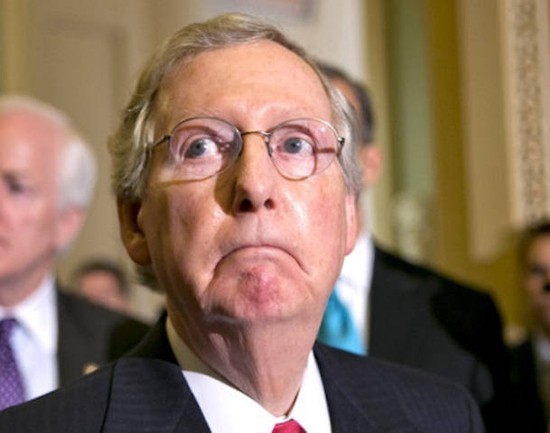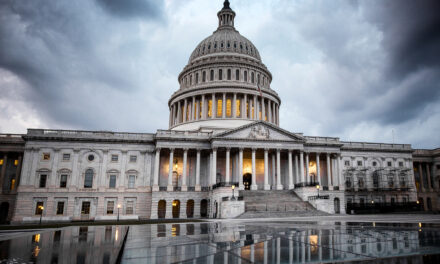One thing I can say with confidence is that what comes after this pandemic will have only a passing resemblance to what preceded it, which means that none of our political assumptions are safe. That definitely goes for the red/blue divide in this country, and for what seats should be considered safe.
The Cook Political Report (subscription only) now believes that the Democrats have a 50 percent chance of winning control of the Senate:
“Biden leading the ticket, instead of Sanders, was the first blow for Republicans, making the ties they’d hoped to make between socialism and the Democratic Party much harder. But then came the COVID-19 outbreak. The Trump administration’s slow reaction to manage this health crisis has many Republicans worrying a souring environment will only further endanger already vulnerable GOP senators.”
“One top Republican strategist described it as the ‘perfect storm’ against them. All these things taken together mean that the chances of Democrats taking back the Senate are rising, and is now close to 50-50 odds.”
I’m a little bit more optimistic than that. I thought the Democrats’ odds were at least that good before the coronavirus crisis overtook the world. They only need a net gain of three seats to win control if Biden wins the election, and a net four seats if he doesn’t (because the vice-president breaks 50-50 ties in the Senate).
The most likely path was for the Democrats to win seats in Arizona, Colorado, Maine and North Carolina. Assuming that Sen. Doug Jones of Alabama won’t be able to hold his seat, that would still be enough to get the Democrats to 50-50. I figured this was not only doable, but likely.
Now I’m wondering what it would take for the Democrats to win a filibuster-proof 60 seats.
Consider that Goldman Sachs is now predicting a 24 percent economic contraction in the second quarter. Or, ponder the possible fallout from senators selling off stocks after receiving a private briefing on the severity of the pandemic threat while keeping their constituents in the dark. All but one of the senators so far implicated are Republicans, including both of the senators representing Georgia.
Until recently, the contest in Montana didn’t look competitive, but now Democratic Governor Steve Bullock has changed course and agreed to run for Steve Daines’s senate seat. The first poll of the race shows it dead-even.
Another race that looks newly competitive is in Alaska, where the Democrats have agreed not to field a candidate. Incumbent Republican Dan Sullivan isn’t even from Alaska and his opponent is an orthopedic surgeon who intended all along to run on health care, which is exorbitantly expensive for Alaskans. Al Gross will run as an independent, but he’ll caucus with the Democrats if he wins. Think of him as a cross between Angus King of Maine and Bernie Sanders of Vermont.
The race in Texas was already looking like it might give the Republicans trouble, with Air Force veteran MJ Heger going up against John Cornyn. But Cornyn will be especially vulnerable as the number two behind Mitch McConnell in the Senate leadership. If this race looked lean-Republican before the crisis, it seems like at least a toss-up now.
And for the same reasons, Mitch McConnell could actually be defeated this time around, as he’s also facing a woman and a military veteran in Amy McGrath. He’s never been very popular at home, often rating as the least liked senator among his own constituents. Kentucky rates as one of Trump’s strongest states, but if they begin to waver a bit on that McConnell could find himself underwater just as Governor Matt Bevin recently did in his reelection bid.
Lindsey Graham seems safe in South Carolina, but his strategy has been to tie himself as closely as possible to Trump. This could backfire on him if the public perceives Trump as having failed as president. Even prior to the pandemic, Graham was looking a little weak in head-to-head polls with Democratic challenger Jaime Harrison.
The political terrain after this becomes more difficult. On paper, the easiest picking is in Iowa where Joni Ernst is seeking reelection, presumably against Theresa Greenfield. Polling has shown the Republicans with stubborn strength in the Hawkeye State, but it’s also a state with a history of swinging either way.
The Democrats are feeling pretty good about their recruit in Kansas. Barbara Bollier is a former Republican who bolted when Sam Brownback’s administration was too much for her. She has the right profile to win this seat that is being vacated by Sen. Pat Roberts, but Kansas hasn’t sent a Democratic senator to Washington since the 1930s.
At this point, I’ve identified 13 Republican-held seats that conceivably fall: Arizona, Colorado, Montana, Maine, North Carolina, South Carolina, Georgia (2), Kentucky, Alaska, Iowa, Kansas, and Texas. That would get the Democrats to 60 seats if Doug Jones wins reelection in Alabama, and 59 if he does not.
For insurance, the Democrats would have to pull off some kind of miracle. There’s an open seat in Tennessee where Lamar Alexander is retiring. Oklahoma Senator Jim Inhofe is one of the senators who sold stocks after being briefed on the coronavirus. Cindy Hyde-Smith, like all Mississippi Republicans, relies on the overwhelming support of white voters and any significant erosion of that support could put her in jeopardy. She has a fairly strong opponent in Mike Espy.
Outside of these races, it’s hard for me to foresee circumstances that could lead to Republican defeats in Wyoming (although it is an open seat), Idaho, South Dakota, West Virginia, or Arkansas. And there are a couple of Democratic seats that aren’t complete locks (e.g. Minnesota, Michigan, and an open seat in New Mexico).
Still, I can picture a political atmosphere in November that is so toxic to incumbent Republican senators that it could produce a net loss of 13 seats. It’s in no way likely to happen, but neither is it impossible.
As I said at the top, the only thing I’m sure about is that the future will only have a passing resemblance to the past. I remember when Ronald Reagan carried 49 states, including Hawaii, Massachusetts and Rhode Island. No matter how safe a state may seem for one party, there are extraordinary circumstances that can defy expectations. This pandemic has the potential to create a very wide range of responses from the electorate. If the response is hostile to Trump and his congressional enablers, there could be a very strong wipeout in the Senate, and a new Democratic president empowered to pass their platform.






